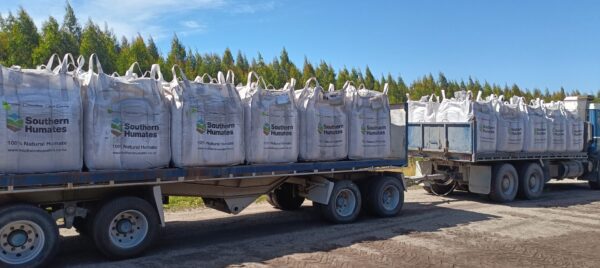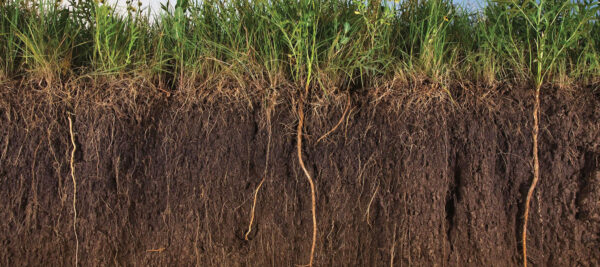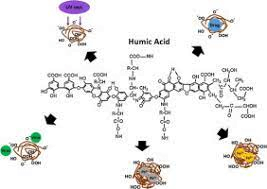HUMATES FOR VITICULTURE

Humates are organic compounds that result from the decomposition of plant and animal matter over an extended period. They are commonly found in natural deposits known as Leonardite, lignite.
Humates consist of complex mixtures of organic compounds, including humic acid, fulvic acid, and humin. These compounds differ in their solubility and molecular weight. Humic acid is the largest molecular fraction and has lower solubility, while fulvic acid is smaller and more soluble. Humin is a complex mixture of organic compounds.
Chemically, humates are composed of carbon, hydrogen, oxygen, nitrogen, and small amounts of other elements such as sulfur and phosphorus. They contain aromatic and aliphatic structures, carboxyl groups, phenolic groups, and various functional groups. These diverse chemical components contribute to the unique properties and functionalities of humates.
Humates possess excellent cation exchange capacity (CEC), which allows them to attract and retain essential nutrients in the soil. They have a high affinity for positively charged ions (cations) such as calcium, magnesium, potassium, and trace elements. This CEC capacity enables humates to hold onto these
nutrients, preventing their leaching and making them available for plant uptake.
Humates exert several mechanisms of action in the soil, leading to numerous beneficial effects on plant growth and soil health. These mechanisms include:
- Soil structure improvement
- Nutrient availability and uptake enhancement
- Microbial activity stimulation
- pH buffering
- Water retention and drought tolerance
- Root development and function
- Enhanced disease resistance
- Suppression of soil-borne pathogens
- Reduction of fungal diseases
- Reduced chemical inputs
Influence of Humate on Grapevine Physiology
Humate-based products have shown significant influence on grapevine physiology, affecting various aspects of plant growth, development, and overall health. Understanding these physiological effects is crucial for viticulturists to harness the benefits of humate in their vineyard management practices. The following sections explore the key areas of grapevine physiology influenced by humate.
Root Development and Function – Humates have been found to promote root growth and enhance root function in grapevines. The organic compounds present in humate products stimulate root elongation, branching, and overall root mass. This increased root system development leads to improved nutrient and water uptake efficiency, enhancing the plant’s ability to withstand environmental stresses such as drought conditions. Humates also enhance the formation of mycorrhizal associations, beneficial symbiotic relationships between grapevine roots and soil fungi, which further enhance nutrient uptake.
Nutrient Uptake and Assimilation – Humates play a vital role in improving nutrient uptake and assimilation in grapevines. They act as natural chelating agents, forming complexes with essential nutrients such as iron, zinc, copper, and manganese, making them more readily available for plant uptake. These chelated nutrients are protected from precipitation or fixation in the soil, ensuring their accessibility to grapevines. Additionally, humates improve cation exchange capacity (CEC) of the soil, promoting the retention and exchange of essential nutrients, preventing nutrient leaching, and reducing the risk of nutrient deficiencies.
Water Relations and Drought Resistance – Water scarcity and drought stress pose significant challenges to grapevine cultivation. Humates have demonstrated the ability to enhance water relations and improve drought resistance in grapevines. By improving soil structure and aggregation, humates increase water-holding capacity, reducing water loss through runoff or evaporation. They also enhance the plant’s ability to retain water in the root zone, thereby prolonging water availability during dry periods. Humate applications have been shown to improve stomatal regulation, reducing transpiration rates and improving water-use efficiency in grapevines, thus mitigating the negative effects of drought stress.
Overall, humates positively influence grapevine physiology by promoting root development, improving nutrient uptake and assimilation, and enhancing water relations. These effects contribute to the overall health and vigor of grapevines, making them more resilient to environmental stresses and optimizing their growth potential. Incorporating humate-based products into vineyard management practices can thus result in healthier grapevines with improved nutrient status, enhanced drought resistance, and ultimately, higher quality grape production.
Enhanced Disease Resistance
Humates have been shown to enhance the grapevine’s defense mechanisms through induced systemic resistance (ISR). ISR is a plant’s ability to mount a broad-spectrum defense response against a wide range of pathogens following exposure to certain beneficial microorganisms or compounds. When humate-based products are applied to grapevines, they can trigger ISR, leading to improved disease resistance.
Humates stimulate the production of various defense-related compounds, such as phytoalexins, pathogenesis-related (PR) proteins, and antioxidants, in grapevines. These compounds act as natural defense mechanisms, inhibiting the growth and spread of pathogens. Additionally, humates enhance the activity of enzymes involved in plant defense, such as peroxidases and chitinases, further contributing to pathogen inhibition.
The induction of systemic resistance by humates not only provides protection against specific pathogens but also enhances the overall resilience of grapevines to various diseases and stresses. This mechanism of action can help reduce the reliance on chemical fungicides and contribute to sustainable disease management practices in viticulture.




